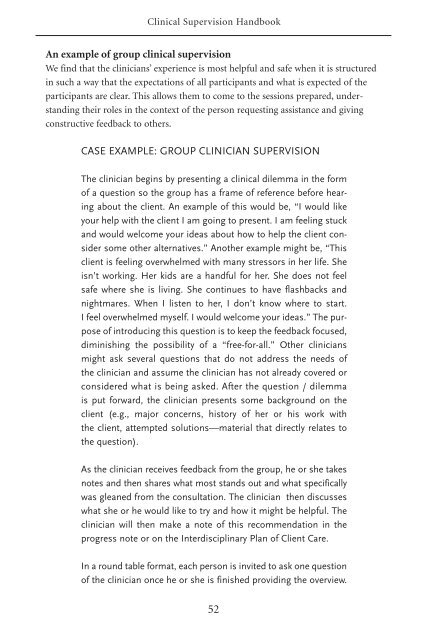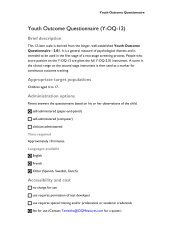Clinical Supervision Handbook - CAMH Knowledge Exchange ...
Clinical Supervision Handbook - CAMH Knowledge Exchange ...
Clinical Supervision Handbook - CAMH Knowledge Exchange ...
You also want an ePaper? Increase the reach of your titles
YUMPU automatically turns print PDFs into web optimized ePapers that Google loves.
<strong>Clinical</strong> <strong>Supervision</strong> <strong>Handbook</strong><br />
An example of group clinical supervision<br />
We find that the clinicians’ experience is most helpful and safe when it is structured<br />
in such a way that the expectations of all participants and what is expected of the<br />
participants are clear. This allows them to come to the sessions prepared, understanding<br />
their roles in the context of the person requesting assistance and giving<br />
constructive feedback to others.<br />
CASE EXAMPLE: GROUP CLINICIAN SUPERVISION<br />
The clinician begins by presenting a clinical dilemma in the form<br />
of a question so the group has a frame of reference before hearing<br />
about the client. An example of this would be, “I would like<br />
your help with the client I am going to present. I am feeling stuck<br />
and would welcome your ideas about how to help the client consider<br />
some other alternatives.” Another example might be, “This<br />
client is feeling overwhelmed with many stressors in her life. She<br />
isn’t working. Her kids are a handful for her. She does not feel<br />
safe where she is living. She continues to have flashbacks and<br />
nightmares. When I listen to her, I don’t know where to start.<br />
I feel overwhelmed myself. I would welcome your ideas.” The purpose<br />
of introducing this question is to keep the feedback focused,<br />
diminishing the possibility of a “free-for-all.” Other clinicians<br />
might ask several questions that do not address the needs of<br />
the clinician and assume the clinician has not already covered or<br />
considered what is being asked. After the question / dilemma<br />
is put forward, the clinician presents some background on the<br />
client (e.g., major concerns, history of her or his work with<br />
the client, attempted solutions—material that directly relates to<br />
the question).<br />
As the clinician receives feedback from the group, he or she takes<br />
notes and then shares what most stands out and what specifically<br />
was gleaned from the consultation. The clinician then discusses<br />
what she or he would like to try and how it might be helpful. The<br />
clinician will then make a note of this recommendation in the<br />
progress note or on the Interdisciplinary Plan of Client Care.<br />
In a round table format, each person is invited to ask one question<br />
of the clinician once he or she is finished providing the overview.<br />
52

















